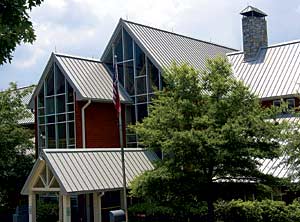Metal Offers Durable, Energy-efficient Roofing Solutions
Potential Installation Problem Areas
 Amicalola Falls State Park & Lodge, Dawsonville, GA Owner: Georgia Department of Natural Resources Roofing Contractor: Roof Craft Systems Inc. Distributor: CRS |
|
Architects should be aware of common installation issues and problems that may result from a faulty design or installation process for metal roofing. Note that in the design stage of the structure, the goal is to achieve positive drainage flow of the water off the roof into properly designed rain-carrying equipment, be this gutters, external or internal drains, or similar means or methods to get water off the roof.
Oil canning: Oil canning refers to deformation, buckling or waviness of the metal. While some oil canning is to be expected in a metal roof, excessive waviness in the panel can be unsightly and is often a source of dispute with the building owner. Oil canning results from either: an uneven substrate; bad source material; rolled-in oil-canning caused by poorly-adjusted rolling equipment; overdriven fasteners; expansion/contraction; or any combination of the above. Some of these conditions-particularly uneven substrates, overdriven fasteners and problems caused by expansion/contraction-can and should be remedied by the installer at the jobsite.
Underlayment: Underlayment should be installed horizontally and staggered (shingle fashion) from eave to ridge.
Fasteners: Typically, a minimum of two fasteners per clip are required per manufacturer's instructions to provide better hold-down strength and prevent the clip from torquing around a single fastener.
Flashing Design: Care must be taken to insure that flashing is designed to accommodate expansion/contraction.
Eave Trim: It is essential that eave trim be stripped in properly.
Jobsite Damage: Care should be taken to make sure that panels are stored properly on the jobsite in a clean, dry place and not scratched due to roof traffic.
Valley Flashing: Valley flashing should be stripped in using a method similar to that for eave flashing. The proper size of valley flashing is determined by roof pitch, panel length, and expected snow loading and rainfall.
Clip Spacing: Proper clip spacing per the manufacturer's details is necessary to insure proper performance of the complete system.
Metal Substrates
Metal roofs have been used for centuries, and have proven to be durable, with both structural and architectural systems remaining operational for a minimum of 30 years, and often for the life of the structure itself. Typically, metal roofs have long useful lives and favorable sustainability ratings as compared with other roofing materials. Metal roofing substrates include metallic-coated steel, aluminum, copper, zinc, and stainless steel. Each material has distinct characteristics and, in particular, the corrosion resistance of a metal roof can vary depending on which substrate is specified.
Steel. Strength, corrosion resistance, longevity and economic value make steel a popular roofing material. Metal roofs are predominantly steel. To increase longevity and anti-corrosiveness, steel undergoes special surface treatments.
Galvanized steel, which has been used for over 75 years in architectural applications, is rendered corrosion resistant by a zinc coating applied to its surface that bonds metallurgically to the steel's surface. Without this zinc coating, steel rusts with oxidization from moisture and oxygen in the air. Zinc provides "sacrificial protection," which means that zinc "repairs" itself if the steel surface is harmed by scratches, nail holes or other damage; zinc molecules move to protect exposed steel. Galvanized steel is available in several grades, specified by coating weight-for example, G-30, G-60, G-90-with the "G" rating referring to the amount of zinc per square foot, per side. G-90 is the weight generally accepted for commercial architectural application. Galvanized steel is sold bare (mill finish) or coated with a paint finish. It accepts many different finishes, and is notable for its low relative expansion and contraction rates. Most common is 24- gauge steel, though panels are available in heavier gauges. ASTM Grade 653 (formerly known as ASTM 446) steel is required for UL-rated assemblies.
More than 30,000 square feet of 24-gauge steel G-90 galvanized panels were used in the renovation of the Amicalola Falls Lodge in the Amicalola State Park near Dawsonville, Georgia. The lodge's cedar shake roof had begun to leak within a year of its installation in the late 1990s. Given the short life span of the original roof, the Georgia Department of Natural Resources (GA DNR) sought a roof system that would provide longevity as well as energy efficiency. The galvanized steel panels feature a 1-inch leg height and a continuous interlock for improved structural performance and wind resistance-a key consideration in view of the severity of the mountaintop storms. Decking was repaired before installation of new standing-seam panels, flashings, vented ridge, gutters, downspouts and vented soffit on the entire structure. "Cool color" gray was an important factor for GA DNR in the selection process, particularly since the agency could obtain this "cool color" with no additional cost over other "non-cool" colors.









